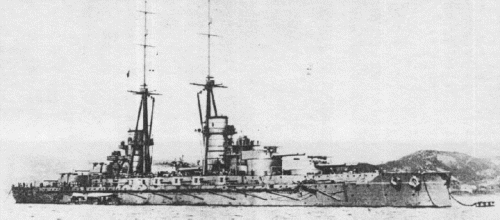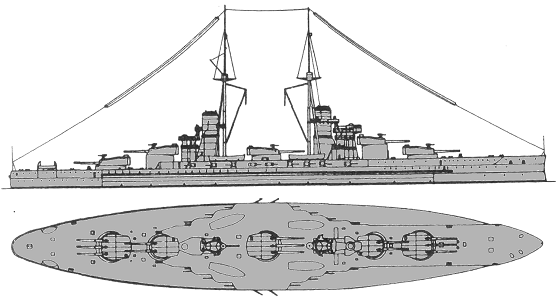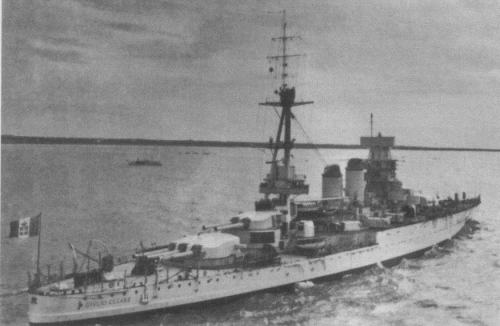
NAVYPEDIA
 Support the project with paypal
Support the project with paypal
Photo

Giulio Cesare 1914
Ships
| Name | No | Yard No | Builder | Laid down | Launched | Comp | Fate |
|---|---|---|---|---|---|---|---|
| Conte di Cavour | R. Arsenale di La Spezia | 10.8.1910 | 10.8.1911 | 1.4.1915 | sunk 12.11.1940 | ||
| Giulio Cesare | Ansaldo, Genoa | 24.6.1910 | 15.10.1911 | 14.5.1914 | to Soviet Union 2.1949 (Новороссийск [Novorossiysk]) | ||
| Leonardo da Vinci | Odero, Sestri Ponente | 18.7.1910 | 14.10.1911 | 17.5.1914 | sunk 2.8.1916 |
Technical data
| Data variant | as completed | modernization 1937 |
|---|---|---|
| Displacement standard, t | --- | 26400 |
| Displacement normal, t | Conte di Cavour: 22922 Giulio Cesare: 23183 Leonardo da Vinci: 23087 |
|
| Displacement full, t | Conte di Cavour: 24250 Giulio Cesare: 24801 Leonardo da Vinci: 24677 |
Conte di Cavour: 29032 Giulio Cesare: 29100 |
| Length, m | 168.9 wl 176.1 oa |
168.9 wl 186.4 oa |
| Breadth, m | 28.0 |
28.6 |
| Draught, m | Conte di Cavour, Leonardo da Vinci: 8.70 normal 9.35 max Giulio Cesare: 8.70 normal 9.43 max |
9.15 normal 10.4 max |
| No of shafts | 4 |
2 |
| Machinery | Conte di Cavour, Leonardo da Vinci: 4 sets Parsons geared steam turbines, 20 Blechynden boilers Giulio Cesare: 4 sets Parsons geared steam turbines, 12 Blechynden + 12 Babcock & Wilcox boilers |
2 sets Beluzzo geared steam turbines, 8 Yarrow boilers |
| Power, h. p. | Conte di Cavour: 31278 Giulio Cesare: 30700 Leonardo da Vinci: 32800 |
75000 (93000 forced) |
| Max speed, kts | Conte di Cavour: 22.2 Giulio Cesare, Leonardo da Vinci: 21.6 |
27 (28 forced) |
| Fuel, t | coal 1450 + oil 850 |
oil 2472 |
| Endurance, nm(kts) | 4800(10) | 6400(13) |
| Armour, mm | belt: 250 - 80, upper belt: 220, turrets: 280, barbettes: 280, battery: 130, CT: 280, main deck: 24 with 40-mm slopes, middle deck: 30, upper deck: 30, forecastle deck: 44 |
belt: 250 - 220, upper belt: 170, turrets: 280, barbettes: 280 + 50, secondary turrets: 120, battery: 130, CT: 260, main deck:100 - 80, upper deck: 44 |
| Armament | Conte di Cavour:: 3 x 3 - 305/46 V1909, 2 x 2 - 305/46 V1909, 18 x 1 - 120/50 V1909, 13 x 1 - 76/50 V1909, 3 - 450 TT sub (1 bow, 2 beam) Giulio Cesare: 3 x 3 - 305/46 A1909, 2 x 2 - 305/46 A1909, 18 x 1 - 120/50 A1909, 13 x 1 - 76/50 A1909, 3 - 450 TT sub (1 bow, 2 beam) Leonardo da Vinci: 3 x 3 - 305/46 V1909, 2 x 2 - 305/46 V1909, 18 x 1 - 120/50 V1909, 14 x 1 - 76/50 V1909, 3 - 450 TT sub (1 bow, 2 beam) |
Giulio Cesare: 2 x 3 - 320/44 M1934, 2 x 2 - 320/44 M1934, 6 x 2 - 120/50 OTO 1933, 4 x 2 - 100/47 OTO 1928, 6 x 2 - 37/54 Breda 1932, 6 x 2 - 13.2/76, 2 catapults, 2 seaplanes (CANT.25, Ro.43, Ro.44) Conte di Cavour: 2 x 3 - 320/44 M1934, 2 x 2 - 320/44 M1934, 6 x 2 - 120/50 OTO 1933, 4 x 2 - 100/47 OTO 1928, 6 x 2 - 37/54 Breda 1932, 6 x 2 - 13.2/76 |
| Complement | 1235 |
1236 |
Standard scale images

Giulio Cesare 1914

Giulio Cesare 1940
Graphics
Project history
Project history: Giulio Cesare class battleships represented the basic fighting power of WWI-era Regia Marina, though they cannot be called too successful. Protection of the ships to beginning of war any more did not meet modern requirements, underwater protection practically was absent, and even the speed, a traditional trump of Italian shipbuilders, yielded to newest dreadnoughts of other countries.
On two survived ships in 1920th serious works on their modernization were not conducted some. To the beginning of 1930s they have ultimately lost battle value, and as the main opponent of Italy on Mediterranean sea, France, had so out-of-date battleships, works on modernization of the ships of Conte di Cavour class were not provided. The situation has changed after it became known about building in France a fast battleship Dunkerque. The answer of Italy was followed quickly enough, but was unusual enough. For some reasons, both economic, and political character, instead of building of the new ship Italy have gone on a way of radical modernization of available ones.
Works on Cavour and Cesare have begun in 1933. Ships lost all artillery, superstructures and have taken apart the most part of the hull above an armour deck. The hull for the purpose of streamlines improvement was extended fwd on 10m, having given to a new stem the modern yacht form. At the expense of liquidation of medium guns casemate a forecastle have extended approximately for 3.5 length of the hull. Old 4-shaft machinery was demounted, having changed on 2-shaft more powerful ones (75000hp, or to 93000hp forced). Progress in the field of ship power plants for 20 years passed from the moment of completion of ships, has allowed at three times more powerful machinery to lower its weight on third. Machinery compartments were arranged in a "chess" order port side turbine set was positioned aft from boiler room, and starboard side turbine set was fwd from boiler room. Medium triple turret between funnels was liquidated, and the number of main guns was shrank to ten 320mms, and it were old 305mms barrels, reamed to new calibre and installed on new carriage ensuring higher elevation angle (27°). Auxiliary guns after modernization presented 120mm/50 guns in six twin turrets, placed on one level amidships. The economy of weight formed at the expense of using of lighter machinery and reduction of main gun turrets number from 5 to 4, has gone on protection increase (extra more than 3000t of armour were installed), basically horizontal, though protection of barbettes and CT was increased also. Underwater protection of Pugliese design consisting of two concentric pipes one in another (internal was "wrecked" or "soft"), also had 25mm protection. Works on both ships have come to the end in 1937. At the moment of joining of Italy to WWII they have appeared unique completely combat-ready battleships.
During restoring repair in 1943 it was planned to rearm Cavour by more modern artillery: 6 twin 135mm/45, 12 single 65mm/64 and 5 twin and 3 single 20mm/65.
Ship protection
as completed: Main belt was 2.8m high and protected full ship length. Its thickness was 250mm between end barbettes tapering to 170mm from middle part at lower edge, decreasing to 80 and 130mm at fore and aft ends respectively. Upper 220mm belt between end barbettes had 2.3m height. Additional 130mm belt between stem and barbette No 4 had 138m length. Main deck had 24mm thickness at flat part and connected with lower edge of main belt by 40mm slopes. 30mm middle deck between barbettes No 1 and 4 laid over upper edge of upper 220mm belt. Upper deck between stem and casemate was 30mm, there was 44mm forecastle deck over casemate. Turrets had 280mm faces, 240mm sides and rears, 85mm crowns. Barbettes had 280mm protection. CT had 280mm sides, reserve aft CT had 180mm protection.
as modernized: Main belt was 2.8m high and protected full ship length. Its thickness was 250mm between end barbettes tapering to 170mm from middle part at lower edge, decreasing to 80 and 130mm at fore and aft ends respectively. Upper 220mm belt between end barbettes had 2.3m height. Additional 130mm belt between stem and barbette No 4 had 138m length. New 70mm sides of citadel inside the hull protected machinery and barbettes between main and middle decks.
Main deck had 50mm thickness at flat part (central part near centerline was absent) and connected with lower edge of main belt by 40mm slopes. Middle deck between barbettes No 1 and 4 laid over upper edge of upper 220mm belt and was 80mm over machinery, 100mm over magazines and 30mm over other parts. Upper deck between stem and casemate was 30mm, there was 44mm forecastle deck over casemate.
Turrets had 240mm faces, sides and rears, 85mm crowns. Barbettes had 280mm protection with additional 50mm plates mounted around them with little spacing. CT had 260mm sides, 120mm roof and 100mm deck. Fwd superstructure had 32-48mm splinter protection.
New torpedo protection of Pugliese design (with 3.4m diameter inner tube) was 7m deep and could resist exploding of 350kg TNT. Longitudinal torpedo bulkhead had 40mm thickness and connected with 70mm side of inner citadel at main deck level.
Modernizations
1920, both survived: + 6 x 1 - 76/40 Ansaldo 1917
1925, both survived: + 2 x 1 - 40/39 Vickers-Terni 1917, 1 seaplane
1926, both survived: + 1 catapult
(10/1933-6/1937), Conte de Cavour; (10/1933-10/1937), Giulio Cesare were modernizaed with data as given in the table.
1937, Giulio Cesare: - 2 catapults with seaplanes
late 1940, both: - 6 x 2 - 13.2/76; + 6 x 2 - 20/65 Breda 1935
1941, Giulio Cesare: + 2 x 2 - 37/54 Breda 1932, 2 x 2 - 20/65 Breda 1935
Naval service
Leonardo da Vinci was sunk 2.8.1916 by internal explosion (sabotage) on Taranto road.
Conte di Cavour was sunk by one air torpedo from British Swordfish (Illustrious air group) at Taranto 12.11.1940 on shallow water and abandoned. She was raised 1.7.1941 and towed off to Trieste. Till September, 1943 repair has not been completed (the ship was in half-year availability). 10.9.1943 she was scuttled by crew. She was raised by Germans in 1943-1944 and sunk by American aircraft 15.2.1945.
Giulio Cesare in battle at Punto Stilo 9.7.1940 received hit of 381mm shell and was under repair 2 months. In 1948 she wass transferred to the USSR, renamed Novorossiysk and lost at Sevastopol 29.10.1955.
 HOME
HOME FIGHTING SHIPS OF THE WORLD
FIGHTING SHIPS OF THE WORLD ITALY
ITALY CAPITAL SHIPS
CAPITAL SHIPS GIULIO CESARE battleships (1914 - 1915)
GIULIO CESARE battleships (1914 - 1915)

